Design of an Efficient PTB7:PC70BM-Based Polymer Solar Cell for 8% Efficiency
Abstract
:1. Introduction
2. Simulation Methods and Physical Parameters
2.1. Simulation Software
2.2. Simulation Method
2.3. Physical Parameters
3. Results and Discussion
3.1. Thickness Optimization of PEDOT:PSS
3.2. Shallow Doping Density Optimization of PEDOT:PSS
3.3. Electron Transport Layer Thickness Optimization
3.4. Shallow Doping Density Optimization of the PFN-Br
3.5. Thickness Optimization of PTB7-PC70BM
3.6. Photo Current–Voltage Response of Proposed Solar Cell
4. Conclusions
Funding
Institutional Review Board Statement
Informed Consent Statement
Data Availability Statement
Acknowledgments
Conflicts of Interest
References
- Peng, W.; Lin, Y.; Jeong, S.Y.; Genene, Z.; Magomedov, A.; Woo, H.Y.; Chen, C.; Wahyudi, W.; Tao, Q.; Deng, J.; et al. Over 18% Ternary Polymer Solar Cells Enabled by a Terpolymer as the Third Component. Nano Energy 2022, 92, 106681. [Google Scholar] [CrossRef]
- Murad, A.R.; Iraqi, A.; Aziz, S.B.; Abdullah, S.N.; Brza, M.A. Conducting Polymers for Optoelectronic Devices and Organic Solar Cells: A Review. Polymers 2020, 12, 2627. [Google Scholar] [CrossRef] [PubMed]
- Ghosekar, I.C.; Patil, G.C. Review on Performance Analysis of P3HT:PCBM-Based Bulk Heterojunction Organic Solar Cells. Semicond. Sci. Technol. 2021, 36, 045005. [Google Scholar] [CrossRef]
- Moiz, S.A.; Nahhas, A.M.; Um, H.-D.; Jee, S.-W.; Cho, H.K.; Kim, S.-W.; Lee, J.-H. A Stamped PEDOT:PSS–Silicon Nanowire Hybrid Solar Cell. Nanotechnology 2012, 23, 145401. [Google Scholar] [CrossRef]
- Moiz, S.A.; Alahmadi, A.N.M.; Karimov, K.S. Improved Organic Solar Cell by Incorporating Silver Nanoparticles Embedded Polyaniline as Buffer Layer. Solid State Electron. 2020, 163, 107658. [Google Scholar] [CrossRef]
- Li, W.; Ye, L.; Li, S.; Yao, H.; Ade, H.; Hou, J. A High-Efficiency Organic Solar Cell Enabled by the Strong Intramolecular Electron Push–Pull Effect of the Nonfullerene Acceptor. Adv. Mater. 2018, 30, e1707170. [Google Scholar] [CrossRef]
- Helgesen, M.; Søndergaard, R.; Krebs, F.C. Advanced Materials and Processes for Polymer Solar Cell Devices. J. Mater. Chem. 2010, 20, 36–60. [Google Scholar] [CrossRef]
- Hau, S.K.; Yip, H.L.; Jen, A.K.Y. A Review on the Development of the Inverted Polymer Solar Cell Architecture. Polym. Rev. 2010, 50, 474–510. [Google Scholar] [CrossRef]
- Chen, C.C.; Chang, W.H.; Yoshimura, K.; Ohya, K.; You, J.; Gao, J.; Hong, Z.; Yang, Y. An Efficient Triple-Junction Polymer Solar Cell Having a Power Conversion Efficiency Exceeding 11%. Adv. Mater. 2014, 26, 5670–5677. [Google Scholar] [CrossRef]
- Malik, A.; Hameed, S.; Siddiqui, M.J.; Haque, M.M.; Umar, K.; Khan, A.; Muneer, M. Electrical and Optical Properties of Nickel- and Molybdenum-Doped Titanium Dioxide Nanoparticle: Improved Performance in Dye-Sensitized Solar Cells. J. Mater. Eng. Perform. 2014, 23, 3184–3192. [Google Scholar] [CrossRef]
- Sharma, N.; Gupta, S.K.; Negi, C.M. Influence of Active Layer Thickness on Photovoltaic Performance of PTB7:PC70BM Bulk Heterojunction Solar Cell. Superlattices Microstruct. 2019, 135, 106278. [Google Scholar] [CrossRef]
- Ramírez-Como, M.; Balderrama, V.S.; Sacramento, A.; Marsal, L.F.; Lastra, G.; Estrada, M. Fabrication and Characterization of Inverted Organic PTB7:PC70BM Solar Cells Using Hf-In-ZnO as Electron Transport Layer. Sol. Energy 2019, 181, 386–395. [Google Scholar] [CrossRef]
- Dridi, C.; Touafek, N.; Mahamdi, R. Inverted PTB7:PC70BM Bulk Heterojunction Solar Cell Device Simulations for Various Inorganic Hole Transport Materials. Optik 2022, 252, 168447. [Google Scholar] [CrossRef]
- Zhang, Z.; Qin, Y. Cross-Conjugated Poly(Selenylene Vinylene)s. Polym. Chem. 2019, 10, 1018–1025. [Google Scholar] [CrossRef]
- Meng, L.; Fan, H.; Lane, J.M.D.; Qin, Y. Bottom-up Approaches for Precisely Nanostructuring Hybrid Organic/Inorganic Multi-Component Composites for Organic Photovoltaics. MRS Adv. 2020, 5, 2055–2065. [Google Scholar] [CrossRef]
- Mola, G.T.; Dlamini, W.E.; Oseni, S.O. Improving Optical Absorption Bandwidth Using Bi-Layer Bulkheterojunction Organic Photoactive Medium. J. Mater. Sci. Mater. Electron. 2016, 27, 11628–11633. [Google Scholar] [CrossRef]
- Louwet, F.; Groenendaal, L.; D’haen, J.; Manca, J.; van Luppen, J.; Verdonck, E.; Leenders, L. PEDOT/PSS: Synthesis, Characterization, Properties and Applications. Synth. Met. 2003, 135–136, 115–117. [Google Scholar] [CrossRef]
- Moiz, S.A.; Alahmadi, A.N.M.; Aljohani, A.J. Design of Silicon Nanowire Array for PEDOT:PSS-Silicon Nanowire-Based Hybrid Solar Cell. Energies 2020, 13, 3797. [Google Scholar] [CrossRef]
- Han, W.; Ren, G.; Liu, J.; Li, Z.; Bao, H.; Liu, C.; Guo, W. Recent Progress of Inverted Perovskite Solar Cells with a Modified PEDOT:PSS Hole Transport Layer. ACS Appl. Mater. Interfaces 2020, 12, 49297–49322. [Google Scholar] [CrossRef]
- Rivnay, J.; Inal, S.; Collins, B.A.; Sessolo, M.; Stavrinidou, E.; Strakosas, X.; Tassone, C.; Delongchamp, D.M.; Malliaras, G.G. Structural Control of Mixed Ionic and Electronic Transport in Conducting Polymers. Nat. Commun. 2016, 7, 11287. [Google Scholar] [CrossRef] [Green Version]
- Bai, Y.; Yu, H.; Zhu, Z.; Jiang, K.; Zhang, T.; Zhao, N.; Yang, S.; Yan, H. High Performance Inverted Structure Perovskite Solar Cells Based on a PCBM:Polystyrene Blend Electron Transport Layer. J. Mater. Chem. A 2015, 3, 9098–9102. [Google Scholar] [CrossRef]
- Yin, H.; Chiu, K.L.; Bi, P.; Li, G.; Yan, C.; Tang, H.; Zhang, C.; Xiao, Y.; Zhang, H.; Yu, W.; et al. Enhanced Electron Transport and Heat Transfer Boost Light Stability of Ternary Organic Photovoltaic Cells Incorporating Non-Fullerene Small Molecule and Polymer Acceptors. Adv. Electron. Mater. 2019, 5, 1900497. [Google Scholar] [CrossRef]
- Niemegeers, A.; Gillis, S.; Burgelman, M. A User Program for Realistic Simulation of Polycrystalline Heterojunction Solar Cells: SCAPS-1D. In Proceedings of the 2nd World Conference on Photovoltaic Energy Conversion, Vienna, Austria, 6–10 July 1998; Joint Research Centre, European Commission: Ispra, Italy, 1998; pp. 672–675. [Google Scholar]
- Burgelman, M.; Nollet, P.; Degrave, S. Modelling Polycrystalline Semiconductor Solar Cells. Thin Solid Films 2000, 361–362, 527–532. [Google Scholar] [CrossRef]
- Verschraegen, J.; Burgelman, M. Numerical Modeling of Intra-Band Tunneling for Heterojunction Solar Cells in Scaps. Thin Solid Films 2007, 515, 6276–6279. [Google Scholar] [CrossRef]
- Nithya, K.S.; Sudheer, K.S. Device Modelling and Optimization Studies on Novel ITIC-OE Based Non-Fullerene Organic Solar Cell with Diverse Hole and Electron Transport Layers. Opt. Mater. 2022, 123, 111912. [Google Scholar] [CrossRef]
- Abdelaziz, W.; Zekry, A.; Shaker, A.; Abouelatta, M. Numerical Study of Organic Graded Bulk Heterojunction Solar Cell Using SCAPS Simulation. Sol. Energy 2020, 211, 375–382. [Google Scholar] [CrossRef]
- Moiz, S.A. Optimization of Hole and Electron Transport Layer for Highly Efficient Lead-Free Cs2TiBr6-Based Perovskite Solar Cell. Photonics 2022, 9, 23. [Google Scholar] [CrossRef]
- Decock, K.; Zabierowski, P.; Burgelman, M. Modeling Metastabilities in Chalcopyrite-Based Thin Film Solar Cells. J. Appl. Phys. 2012, 111, 43703. [Google Scholar] [CrossRef] [Green Version]
- Moiz, S.A.; Alahmadi, A.N.M. Design of Dopant and Lead-Free Novel Perovskite Solar Cell for 16.85% Efficiency. Polymers 2021, 13, 2110. [Google Scholar] [CrossRef]
- Ndiaye, N.S.; Simonetti, O.; Nguyen, T.P.; Giraudet, L. Generation-Recombination in Disordered Organic Semiconductor: Application to the Characterization of Traps. Org. Electron. 2021, 99, 106350. [Google Scholar] [CrossRef]
- McMahon, D.P.; Troisi, A. Organic Semiconductors: Impact of Disorder at Different Timescales. ChemPhysChem 2010, 11, 2067–2074. [Google Scholar] [CrossRef] [PubMed]
- Karimov, K.; Ahmed, M.M.; Moiz, S.A.; Babadzhanov, P.; Marupov, R.; Turaeva, M.A. Electrical Properties of Organic Semiconductor Orange Nitrogen Dye Thin Films Deposited from Solution at High Gravity. Eurasian Chem. Technol. J. 2007, 5, 109. [Google Scholar] [CrossRef]
- Moiz, S.A.; Karimov, K.; Gohar, N.D. Orange Dye Thin Film Resistive Hygrometers. Eurasian Chem. Technol. J. 2017, 6, 179. [Google Scholar] [CrossRef]
- Moiz, S.A.; Alahmadi, A.N.M.; Aljohani, A.J. Design of a Novel Lead-Free Perovskite Solar Cell for 17.83% Efficiency. IEEE Access 2021, 9, 54254–54263. [Google Scholar] [CrossRef]
- Hedley, G.J.; Ward, A.J.; Alekseev, A.; Howells, C.T.; Martins, E.R.; Serrano, L.A.; Cooke, G.; Ruseckas, A.; Samuel, I.D.W. Determining the Optimum Morphology in High-Performance Polymer-Fullerene Organic Photovoltaic Cells. Nat. Commun. 2013, 4, 2867. [Google Scholar] [CrossRef] [Green Version]
- Khelifi, S.; Voroshazi, E.; Spoltore, D.; Piersimoni, F.; Bertho, S.; Aernouts, T.; Manca, J.; Lauwaert, J.; Vrielinck, H.; Burgelman, M. Effect of Light Induced Degradation on Electrical Transport and Charge Extraction in Polythiophene:Fullerene (P3HT:PCBM) Solar Cells. Sol. Energy Mater. Sol. Cells 2014, 120, 244–252. [Google Scholar] [CrossRef]
- Sharma, B.; Mathur, A.S.; Rajput, V.K.; Singh, I.K.; Singh, B.P. Device Modeling of Non-Fullerene Organic Solar Cell by Incorporating CuSCN as a Hole Transport Layer Using SCAPS. Optik 2022, 251, 168457. [Google Scholar] [CrossRef]
- Lattante, S. Electron and Hole Transport Layers: Their Use in Inverted Bulk Heterojunction Polymer Solar Cells. Electronics 2014, 3, 132–164. [Google Scholar] [CrossRef]
- Kim, G.W.; Shinde, D.V.; Park, T. Thickness of the Hole Transport Layer in Perovskite Solar Cells: Performance versus Reproducibility. RSC Adv. 2015, 5, 99356–99360. [Google Scholar] [CrossRef]
- Zhao, Z.; Chen, X.; Liu, Q.; Wu, Q.; Zhu, J.; Dai, S.; Yang, S. Efficiency Enhancement of Polymer Solar Cells via Zwitterion Doping in PEDOT:PSS Hole Transport Layer. Org. Electron. 2015, 27, 232–239. [Google Scholar] [CrossRef]
- Skompska, M.; Mieczkowski, J.; Holze, R.; Heinze, J. In Situ Conductance Studies of P- and n-Doping of Poly(3,4-Dialkoxythiophenes). J. Electroanal. Chem. 2005, 577, 9–17. [Google Scholar] [CrossRef]
- Tanase, C.; Blom, P.W.M.; de Leeuw, D.M. Origin of the Enhanced Space-Charge-Limited Current in Poly(p-Phenylene Vinylene). Phys. Rev. B 2004, 70, 193202. [Google Scholar] [CrossRef] [Green Version]
- Chung, D.S.; Lee, N.H.; Yang, C.; Hong, K.; Park, C.E.; Park, J.W.; Kwon, S.K. Origin of High Mobility within an Amorphous Polymeric Semiconductor: Space-Charge-Limited Current and Trap Distribution. Appl. Phys. Lett. 2008, 93, 033303. [Google Scholar] [CrossRef] [Green Version]
- Karimov, K.S.; Qazi, I.; Moiz, S.A.; Murtaza, I. Electrical Properties of Organic Semiconductor Copper Phthalocyanine Thin Films Deposited from Solution at High Gravity. Optoelectron. Adv. Mater. Rapid Commun. 2008, 2, 219–223. [Google Scholar]
- Qi, B.; Wang, J. Open-Circuit Voltage in Organic Solar Cells. J. Mater. Chem. 2012, 22, 24315–24325. [Google Scholar] [CrossRef]
- Ye, L.; Zhang, S.; Zhao, W.; Yao, H.; Hou, J. Highly Efficient 2D-Conjugated Benzodithiophene-Based Photovoltaic Polymer with Linear Alkylthio Side Chain. Chem. Mater. 2014, 26, 3603–3605. [Google Scholar] [CrossRef]
- Heeger, A.J. 25th Anniversary Article: Bulk Heterojunction Solar Cells: Understanding the Mechanism of Operation. Adv. Mater. 2014, 26, 10–28. [Google Scholar] [CrossRef]
- Nam, S.; Seo, J.; Woo, S.; Kim, W.H.; Kim, H.; Bradley, D.D.C.; Kim, Y. Inverted Polymer Fullerene Solar Cells Exceeding 10% Efficiency with Poly(2-Ethyl-2-Oxazoline) Nanodots on Electron-Collecting Buffer Layers. Nat. Commun. 2015, 6, 8929. [Google Scholar] [CrossRef] [Green Version]
- Nam, S.; Song, M.; Kim, H.; Bradley, D.D.C.; Kim, Y. Thickness Effect of Bulk Heterojunction Layers on the Performance and Stability of Polymer:Fullerene Solar Cells with Alkylthiothiophene-Containing Polymer. ACS Sustain. Chem. Eng. 2017, 5, 9263–9270. [Google Scholar] [CrossRef]
- Lenes, M.; Koster, L.J.A.; Mihailetchi, V.D.; Blom, P.W.M. Thickness Dependence of the Efficiency of Polymer: Fullerene Bulk Heterojunction Solar Cells. Appl. Phys. Lett. 2006, 88, 243502. [Google Scholar] [CrossRef] [Green Version]
- Mouĺ, A.J.; Bonekamp, J.B.; Meerholz, K. The Effect of Active Layer Thickness and Composition on the Performance of Bulk-Heterojunction Solar Cells. J. Appl. Phys. 2006, 100, 094503. [Google Scholar] [CrossRef]
- Park, S.; Jeong, J.; Hyun, G.; Kim, M.; Lee, H.; Yi, Y. The Origin of High PCE in PTB7 Based Photovoltaics: Proper Charge Neutrality Level and Free Energy of Charge Separation at PTB7/PC71BM Interface. Sci. Rep. 2016, 6, 35262. [Google Scholar] [CrossRef]
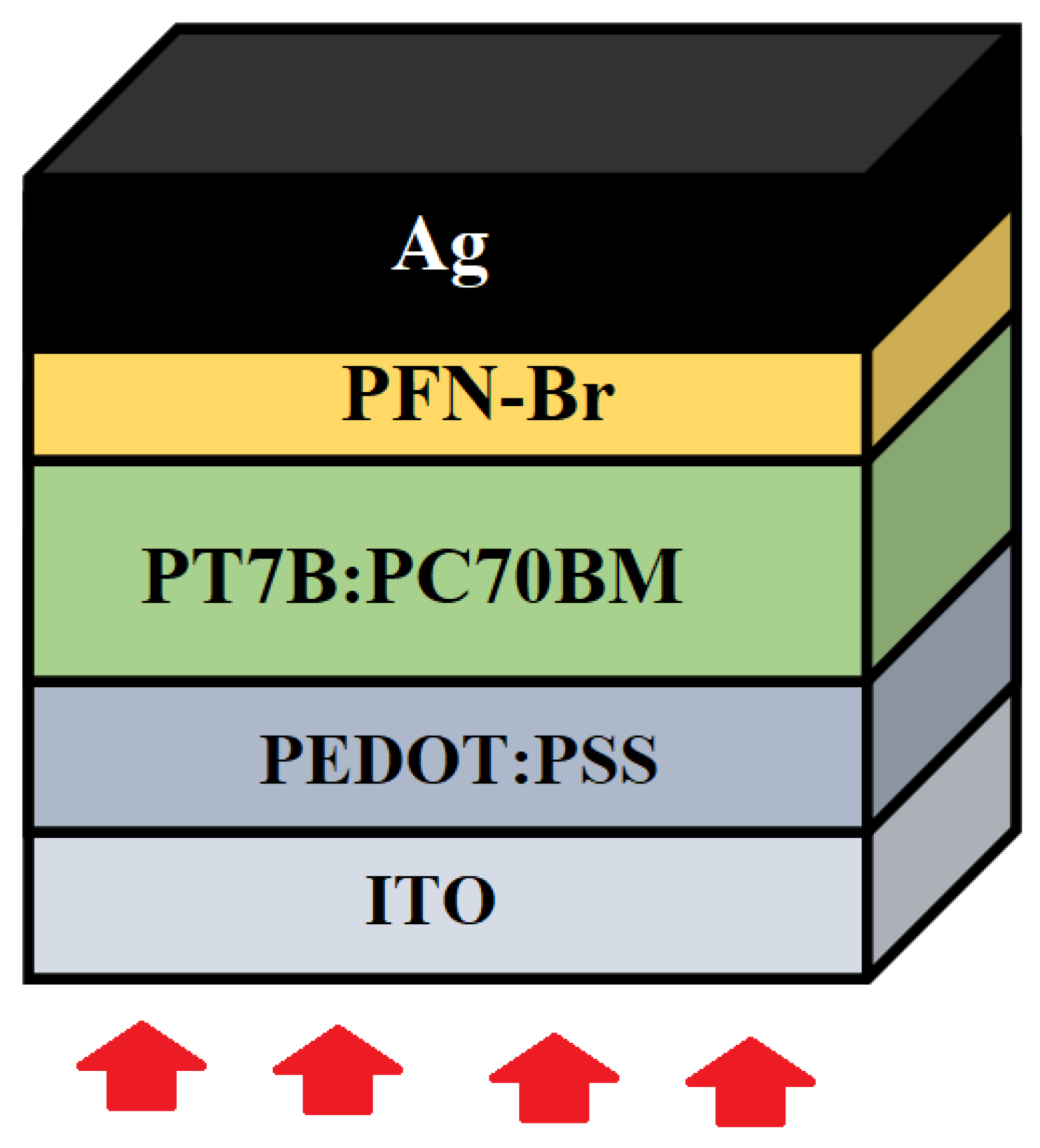
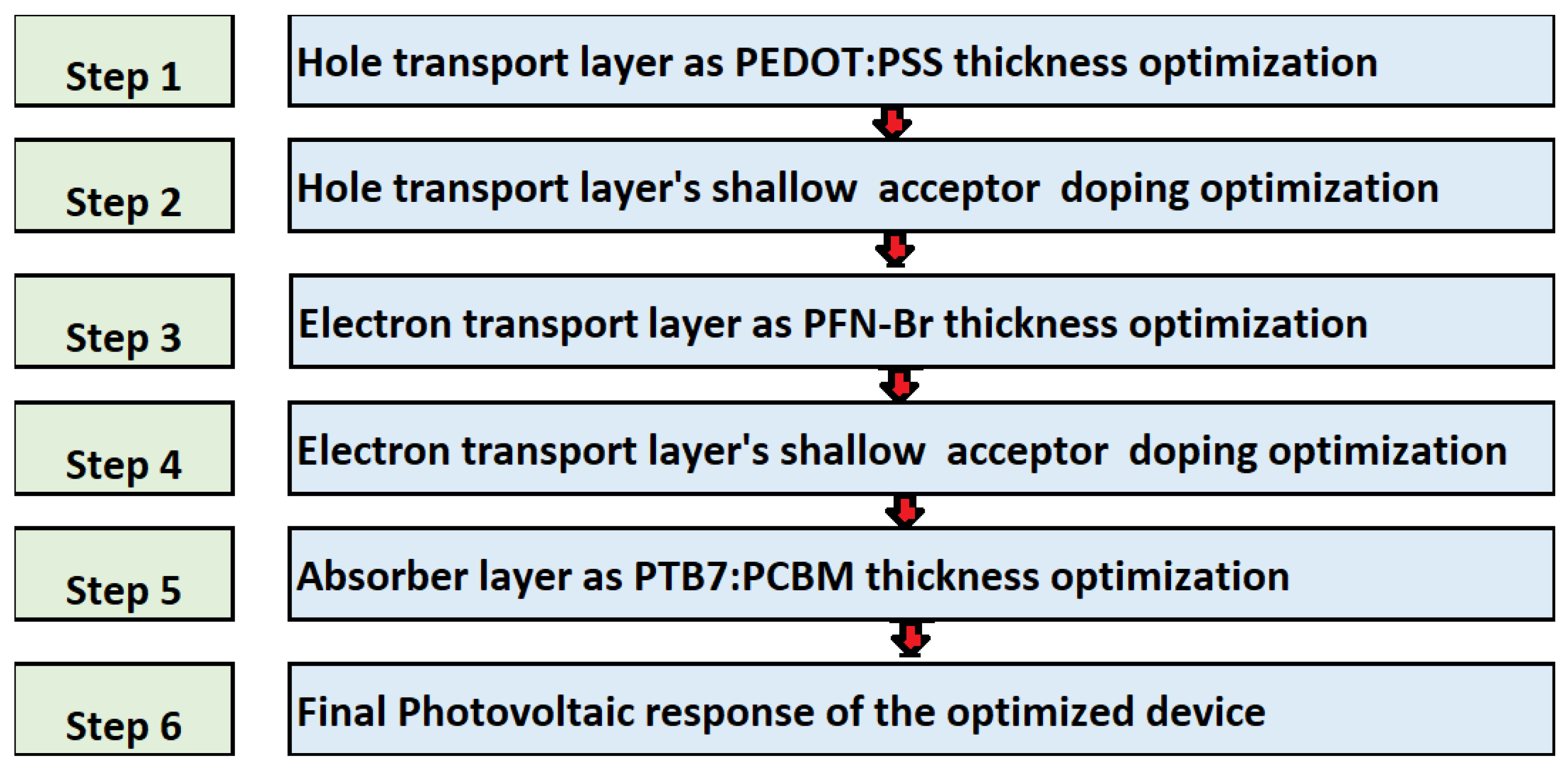
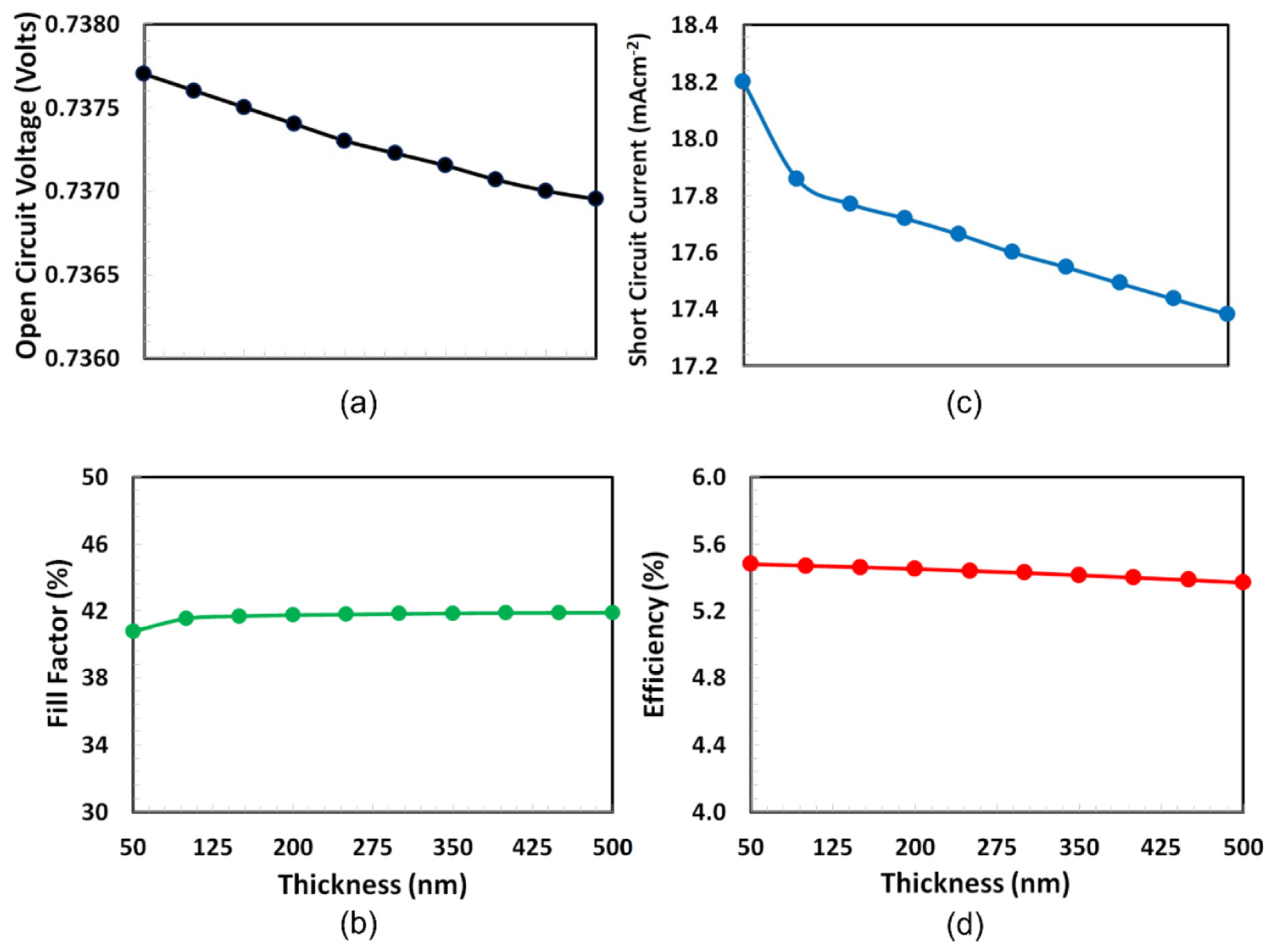


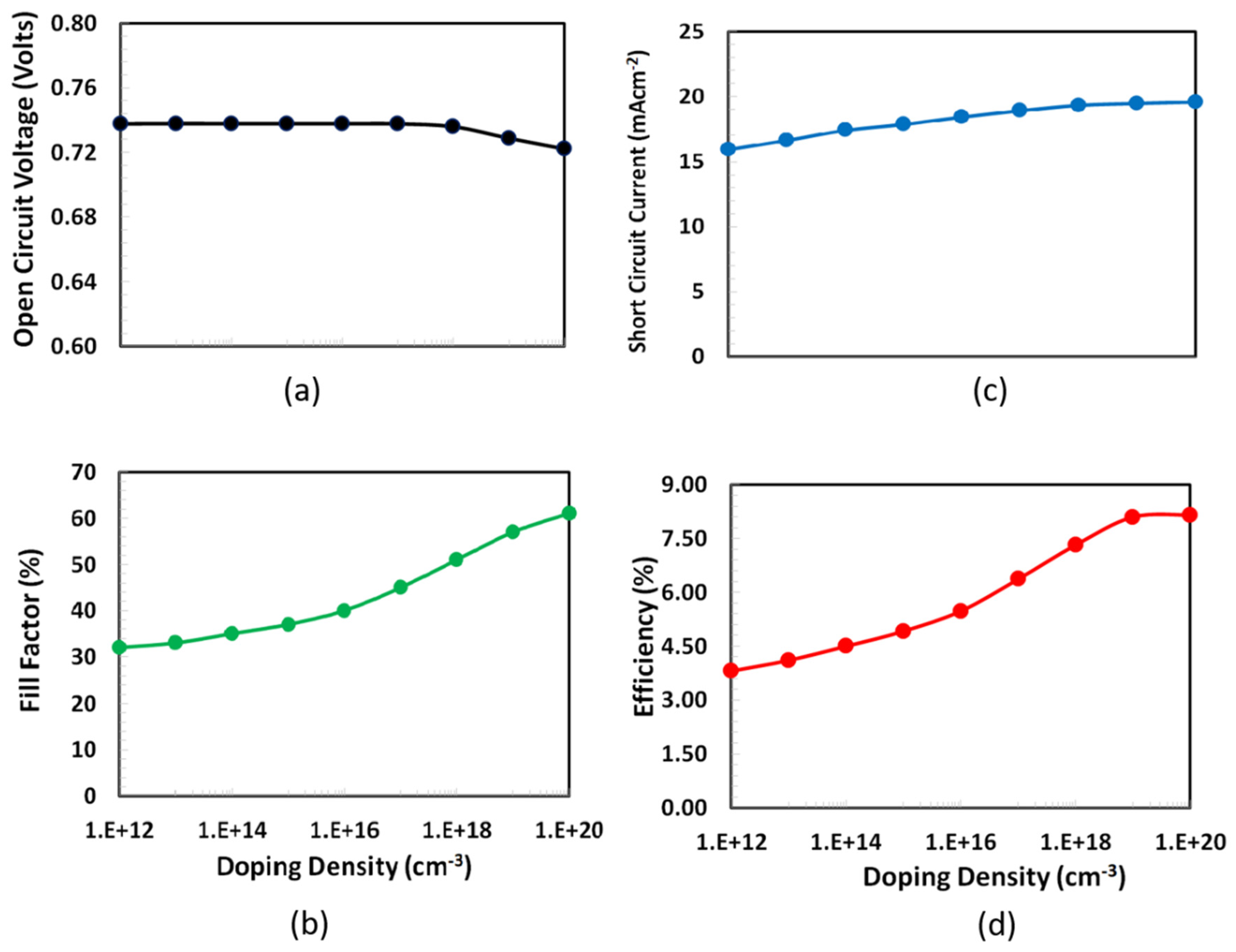

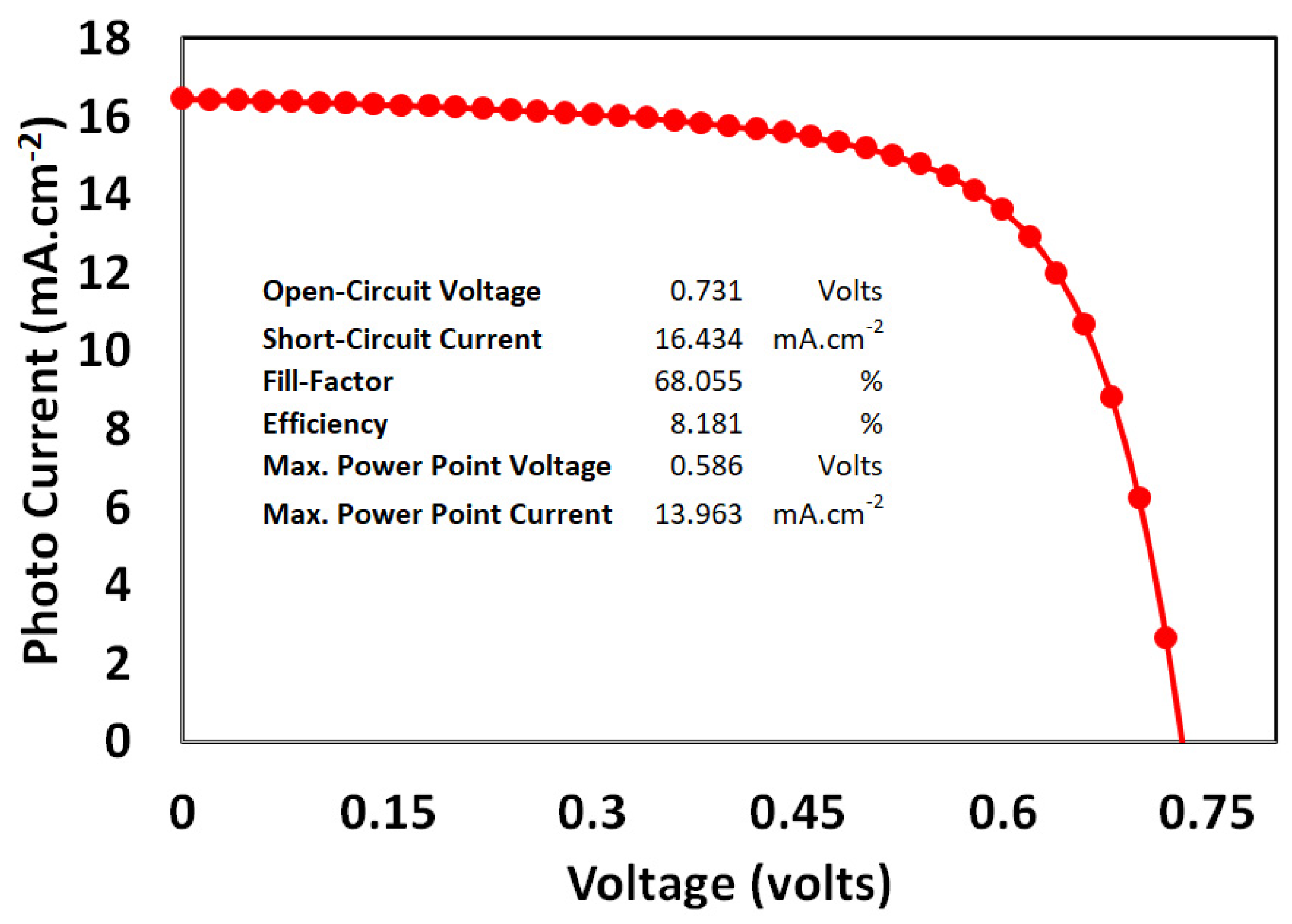
| Physical Parameters | Symbol | Unit | PEDOT:PSS | PTB7:PC70BM | PFN-Br |
|---|---|---|---|---|---|
| Thickness | Th | Nm | - | 250 | 250 |
| Energy Band Gap | Eg | eV | 1.6 | 0.9 | 2.98 |
| Electron Affinity | Χ | eV | 3.5 | 3.7 | 4 |
| Dielectric Permittivity (Relative) | Ε | - | 3 | 3.9 | 5 |
| Effective Density of States at Valence Band | NV | cm−3 | 1 × 1022 | 1 × 1018 | 1 × 1019 |
| Effective Density of States at Conduction Band | NC | cm−3 | 1 × 1022 | 1 × 1018 | 1 × 1019 |
| Hole Thermal Velocity | Ve | cm/s | 1 × 107 | 1 × 107 | 1 × 107 |
| electron Thermal Velocity | Vh | cm/s | 1 × 107 | 1 × 107 | 1 × 107 |
| Electron Mobility | μe | cm2/V.s | 0.01 | 5.00 × 10−4 | 1.00 × 10−4 |
| Hole Mobility | μh | cm2/V.s | 9.9 × 10−0.5 | 5.00 × 10−4 | 2.00 × 10−6 |
| Uniform Shallow Donor Doping | Nd | cm−3 | 0.00 | 1 × 1019 | - |
| Uniform Shallow Acceptor Doping | Na | cm−3 | - | 1 × 1019 | 0 |
| Defect Density | Nt | cm−3 | 1 × 1015 | 1 × 1015 | 1 × 1015 |
| References | [35] | [36,37] | [38] |
Publisher’s Note: MDPI stays neutral with regard to jurisdictional claims in published maps and institutional affiliations. |
© 2022 by the author. Licensee MDPI, Basel, Switzerland. This article is an open access article distributed under the terms and conditions of the Creative Commons Attribution (CC BY) license (https://creativecommons.org/licenses/by/4.0/).
Share and Cite
Alahmadi, A.N.M. Design of an Efficient PTB7:PC70BM-Based Polymer Solar Cell for 8% Efficiency. Polymers 2022, 14, 889. https://doi.org/10.3390/polym14050889
Alahmadi ANM. Design of an Efficient PTB7:PC70BM-Based Polymer Solar Cell for 8% Efficiency. Polymers. 2022; 14(5):889. https://doi.org/10.3390/polym14050889
Chicago/Turabian StyleAlahmadi, Ahmed N. M. 2022. "Design of an Efficient PTB7:PC70BM-Based Polymer Solar Cell for 8% Efficiency" Polymers 14, no. 5: 889. https://doi.org/10.3390/polym14050889
APA StyleAlahmadi, A. N. M. (2022). Design of an Efficient PTB7:PC70BM-Based Polymer Solar Cell for 8% Efficiency. Polymers, 14(5), 889. https://doi.org/10.3390/polym14050889






